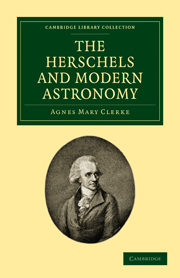Book contents
- Frontmatter
- PREFACE
- Contents
- ILLUSTRATIONS
- CHAPTER I EARLY LIFE OF WILLIAM HERSCHEL
- CHAPTER II THE KING'S ASTRONOMER
- CHAPTER III THE EXPLORER OF THE HEAVENS
- CHAPTER IV HERSCHEL'S SPECIAL INVESTIGATIONS
- CHAPTER V THE INFLUENCE OF HERSCHEL'S CAREER ON MODERN ASTRONOMY
- CHAPTER VI CAROLINE HERSCHEL
- CHAPTER VII SIR JOHN HERSCHEL AT CAMBRIDGE AND SLOUGH
- CHAPTER VIII EXPEDITION TO THE CAPE
- CHAPTER IX LIFE AT COLLINGWOOD
- CHAPTER X WRITINGS AND EXPERIMENTAL INVESTIGATIONS
- INDEX
- Plate section
CHAPTER VII - SIR JOHN HERSCHEL AT CAMBRIDGE AND SLOUGH
Published online by Cambridge University Press: 05 October 2010
- Frontmatter
- PREFACE
- Contents
- ILLUSTRATIONS
- CHAPTER I EARLY LIFE OF WILLIAM HERSCHEL
- CHAPTER II THE KING'S ASTRONOMER
- CHAPTER III THE EXPLORER OF THE HEAVENS
- CHAPTER IV HERSCHEL'S SPECIAL INVESTIGATIONS
- CHAPTER V THE INFLUENCE OF HERSCHEL'S CAREER ON MODERN ASTRONOMY
- CHAPTER VI CAROLINE HERSCHEL
- CHAPTER VII SIR JOHN HERSCHEL AT CAMBRIDGE AND SLOUGH
- CHAPTER VIII EXPEDITION TO THE CAPE
- CHAPTER IX LIFE AT COLLINGWOOD
- CHAPTER X WRITINGS AND EXPERIMENTAL INVESTIGATIONS
- INDEX
- Plate section
Summary
“The little boy is entertaining, comical, and promising,” Dr. Burney wrote after his visit to Slough in 1797. John Frederick William Herschel was then five years old, having been born “within the shadow of the great telescope” March 7, 1792. He was an industrious little fellow, especially in doing mischief. “When one day I was sitting beside him,” his aunt relates, “listening to his prattle, my attention was drawn by his hammering to see what he might be about, and I found that it was the continuation of many days' labour, and that the ground about the corner of the house was undermined, the corner-stone entirely away, and he was hard at work going on with the next. I gave the alarm, and old John Wiltshire, a favourite carpenter, came running, crying out, ‘God bless the boy, if he is not going to pull the house down!’” And she wrote to him at Feldhausen; “I see you now in idea, running about in petticoats among your father's carpenters, working with little tools of your own, and John Wiltshire crying out, ‘Dang the boy, if he can't drive in a nail as well as I can!’”
“John and I,” she told his wife, “were the most affectionate friends, and many a half or whole holiday spent with me was dedicated to making experiments in chemistry, in which generally all boxes, tops of tea-canisters, pepper-boxes, teacups, etc., served for the necessary vessels, and the sand-tub furnished the matter to be analysed.
- Type
- Chapter
- Information
- The Herschels and Modern Astronomy , pp. 142 - 161Publisher: Cambridge University PressPrint publication year: 2010First published in: 1895

